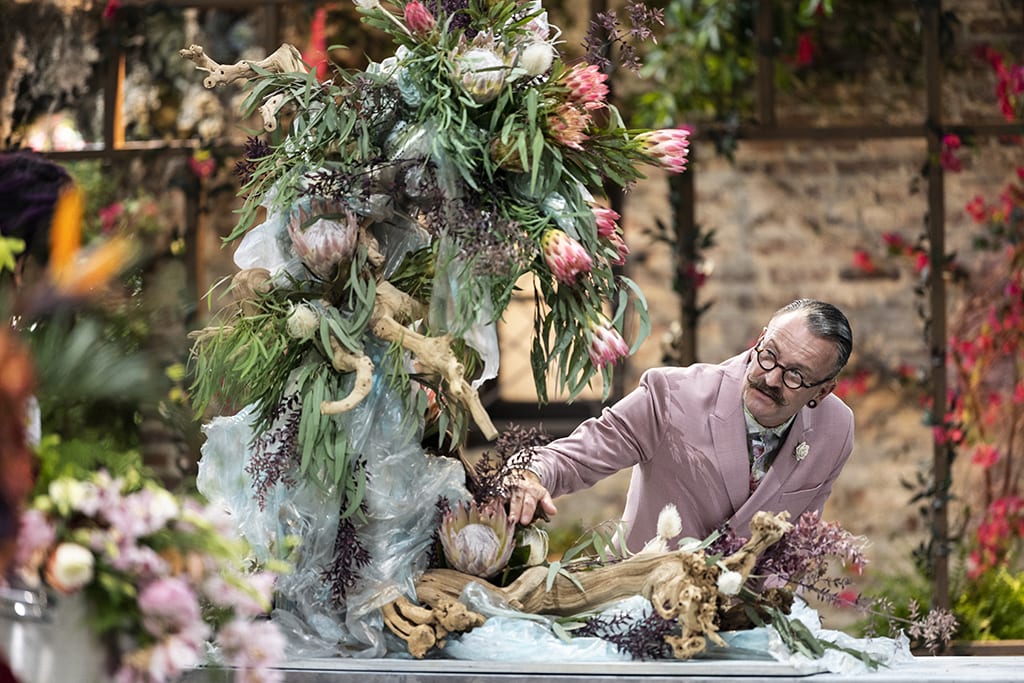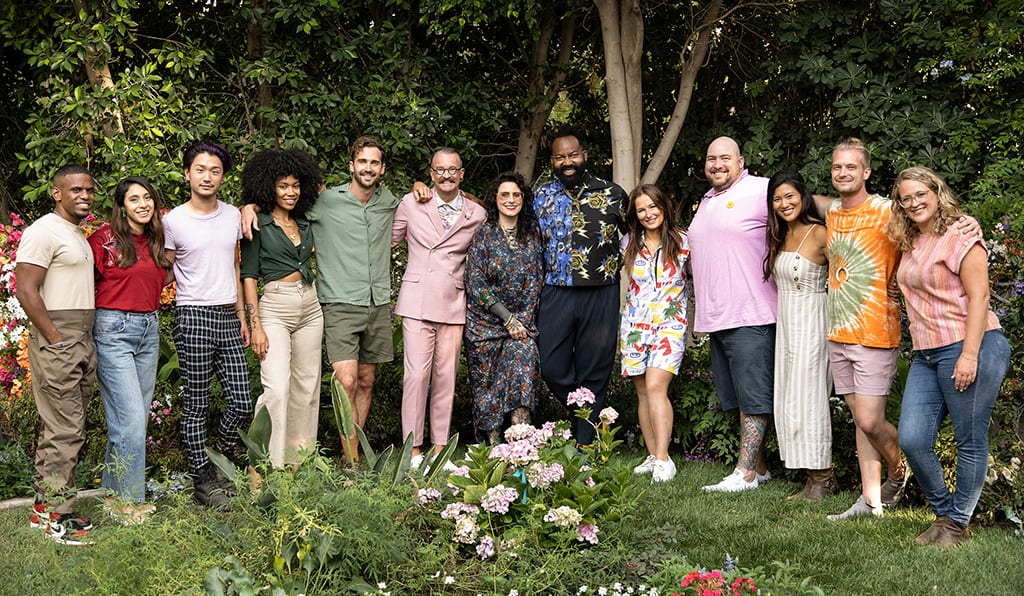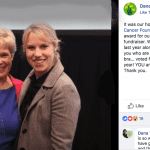
Simon Lycett assessing one of the entries from the first episode. Photo by Anne Marie Fox / HBOMAX.
The latest entry in the category of “floral-design reality TV” promises a distinctive focus on artistry and professionalism. Viewers can still expect all the suspense and entertainment value of an elimination competition with a $100,000 prize — but to floral industry insiders, watching “Full Bloom” on HBO Max may most recall a visit to the bustling workroom of an American Institute of Floral Designers Symposium.
Production on “Full Bloom” started early in 2020, then was halted by the pandemic. Under strict protocols to protect the hosts, participants and crew, it resumed in August — winding up after five weeks of shooting, when the Society of American Florists was treated to an exclusive press briefing with four of the show’s guiding talents. Serving as judges and as mentors to the contestants were Elizabeth Cronin of Asrai Garden in Wicker Park (Chicago), Illinois; Maurice Harris of Bloom and Plume, Los Angeles; and Simon Lycett, world-renowned floral decorator and stylist from the United Kingdom. Wes Dening is the show’s executive producer and co-creator.

The three judges conferring: Simon Lycett, Elizabeth Cronin, Maurice Harris. Photo by Anne Marie Fox / HBOMAX.
While the eight one-hour episodes of “Full Bloom” will certainly feature some over-the-top challenges along with smaller-scale projects, the idea has always been to remain grounded in the foundational skills of floristry.
“This isn’t a show that’s all just about doing big crazy wacky installations,” said Dening. “Anyone watching the show is going to get amazing takeaways. We wanted to show not just the magic and the beauty, but also the hard work and the precision involved in creating floral art.”
Harris cites a challenge where contestants had to design a wedding bouquet pretty enough to be featured on a website, but sturdy enough to withstand the rigors of shipping.
“The key is, don’t put a flower on the outside that’s going to easily break,” he noted. “You want to make sure you have greens on the outside to protect the inside.” That’s the kind of detail that enters into the judges’ decisions, in each episode, on which contestant to eliminate. “It was quite difficult,” said Harris, “and boy, was it a roller coaster ride,” with some surprising turnouts as the show progresses.
Each of the judges brings a different experience and perspective to the show, according to Lycett, “but we all bring relatively traditional, old-school values of floristry, floral art, and creativity to the process. Every single challenge involves checking on mechanics and on flower quality. We’re judging on all the criteria that actually matter when you’re working in a regular flower shop on a daily basis.”
Contestants compete both individually and as ad-hoc teams — which means, Cronin observed, that “they learn from each other. They love to share tips and help each other succeed; then they compete against each other, and then again they help each other succeed. It’s beautiful!”
Selecting for Skills and Diversity
To be accepted as a contestant, applicants had to show a good foundation, at least, in floristry skills.
“We received hundreds of applications,” Dening explained. “Of those, we had hundreds make arrangements in their homes, which they then presented as part of their casting reel. Once we got to know them, we brought the best 20 to Los Angeles.” Those 20 all went through a series of challenges, which were then assessed by professional florists to find the top ten among them.
Even so, the contestants — ranging in age from their twenties to their forties — bring widely differing backgrounds and aspirations to the show, a factor that facilitates cross-sharing of skills and ideas.

All ten contestants from the first episode, with judges Lycett, Cronin, and Harris at center. Photo by Anne Marie Fox / HBOMAX.
“Some have a tight, nineties pavé style,” said Harris. “Some have the loose, Instagram, ‘I-make-one-bouquet-a-day’ style. And then some people work in a traditional flower shop and know how to do that. Others don’t have a lot of experience but do have a vision. So, it runs the gamut in terms of what people bring to the table, and the amount of sharing among them has been really cool.”
After production was initially shut down by the pandemic, producers decided to start over again from the beginning for the sake of continuity. To make the filming covid-safe for all involved, production took place at a big ranch north of LA — “a huge outdoor location with lots of beautiful natural light,” said Dening.
Judges and contestants were unmasked, but all crew members — about 130 people — were required to wear masks and abide by safe social distancing practices. All were tested at least once a week, most crew members three times a week, especially those on the set, which was broken up into “pods”— a measure designed to minimize exposure between the pods.
Flower Joy, Floral Art
As after AIFD Symposium and other floral-industry events where vast amounts of flowers are used, each episode of “Full Bloom” ends with a surprise gift of flowers from the show to unsuspecting recipients — front-line hospital workers, for example. The end goal, said Lycett, is to promote appreciation both of flowers and of floral art.
“Everybody can put flowers into a vase,” he explained, “and I would wish to encourage everybody to do that, because of the now widely confirmed medical and well-being benefits to being among flowers and plant material.”
What florists do, however, goes of course far beyond plopping flowers into a vase. “For me,” said Lycett, “the joy of ‘Full Bloom’ has been that we have been able to showcase floristry and flowers as an art form, be it a party piece that’s over 12 feet tall or a creative design for your dining table at home.”
Bruce Wright is a contributing writer for the Society of American Florists.



